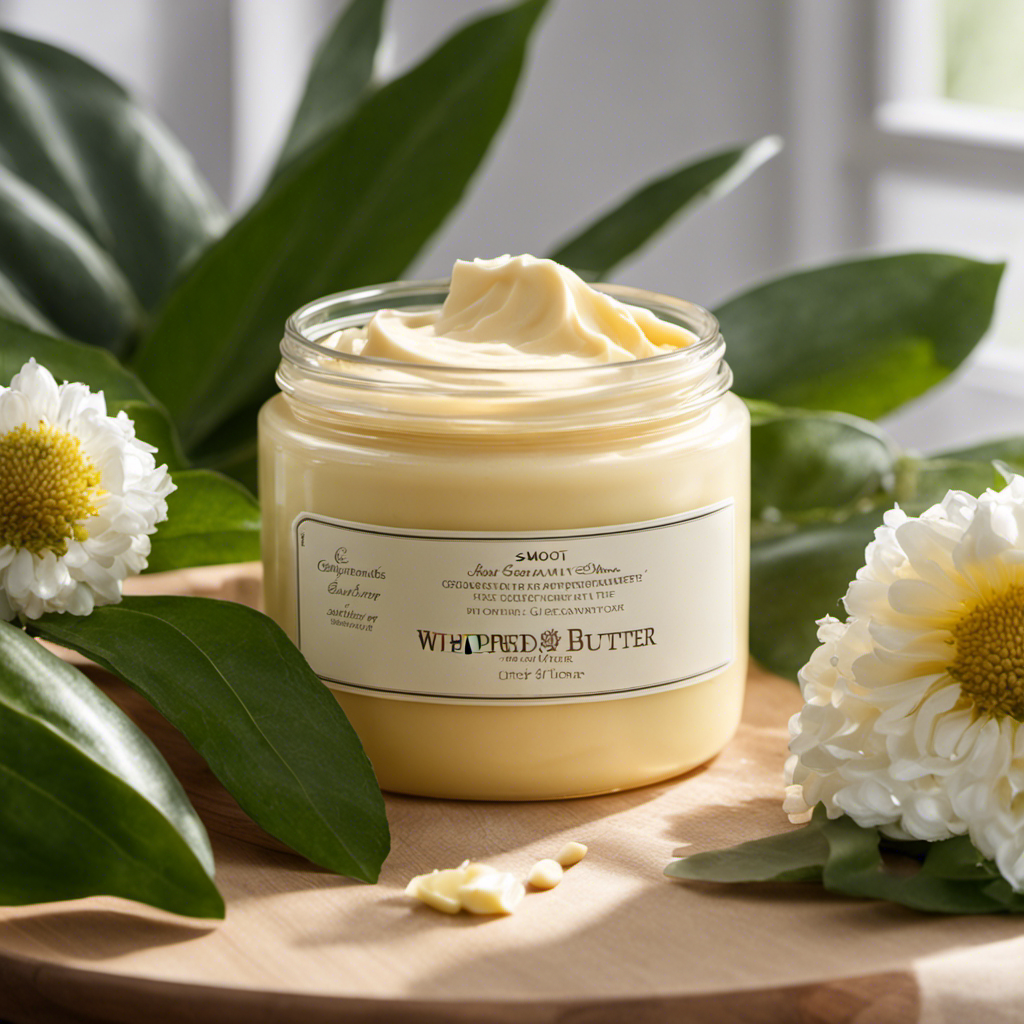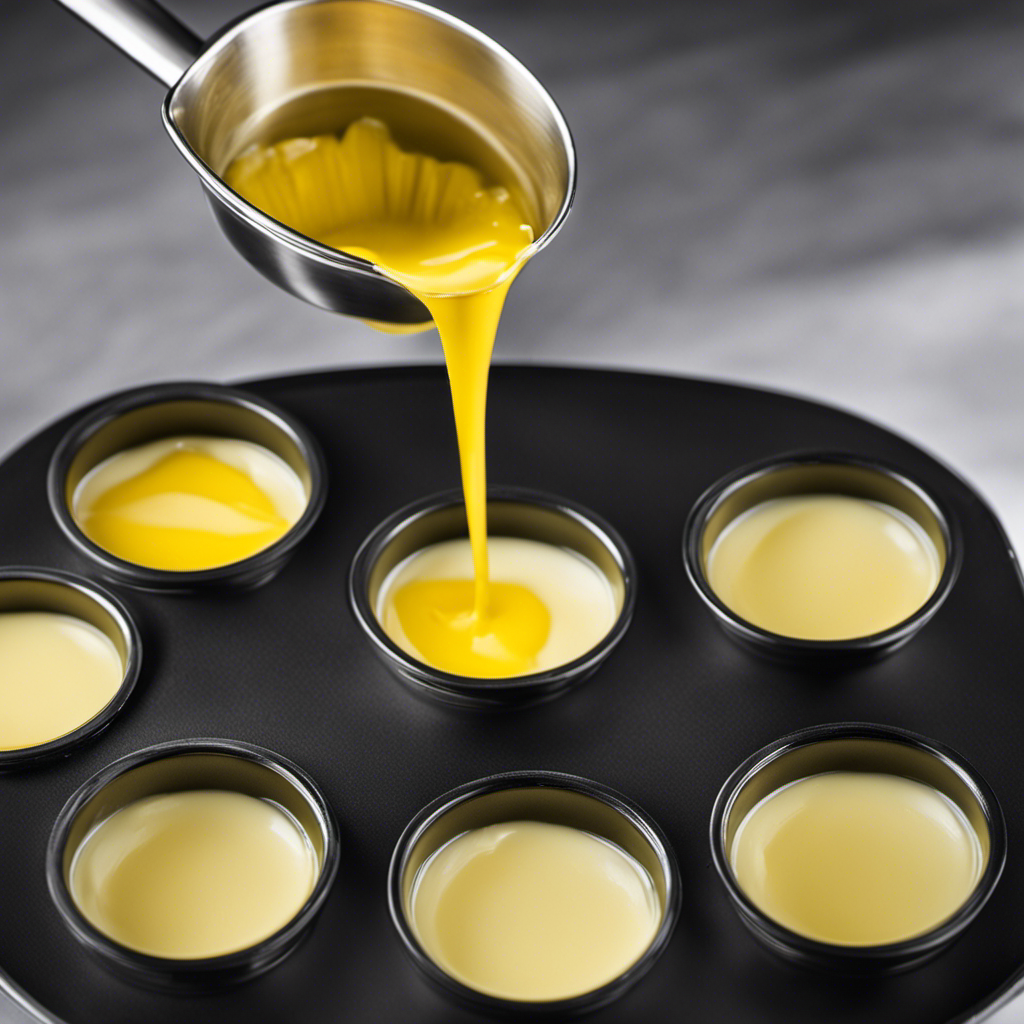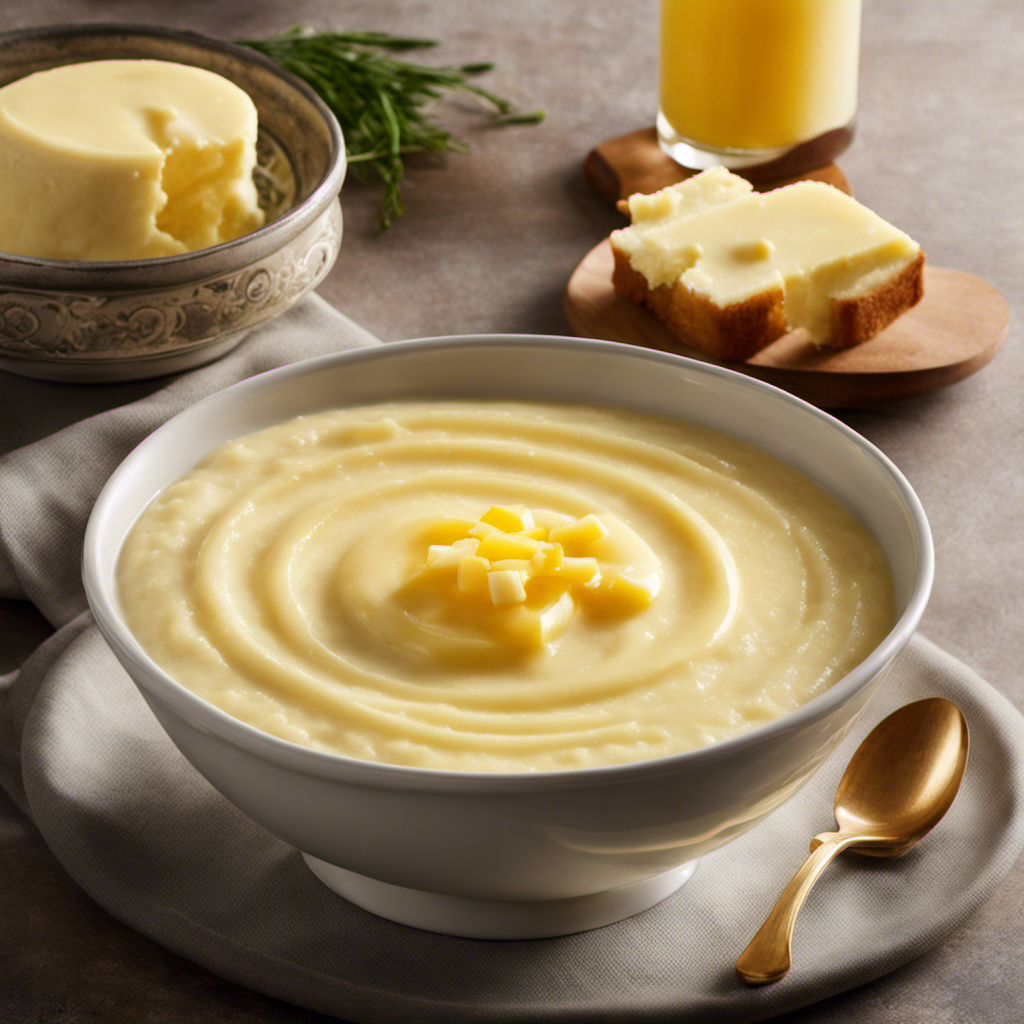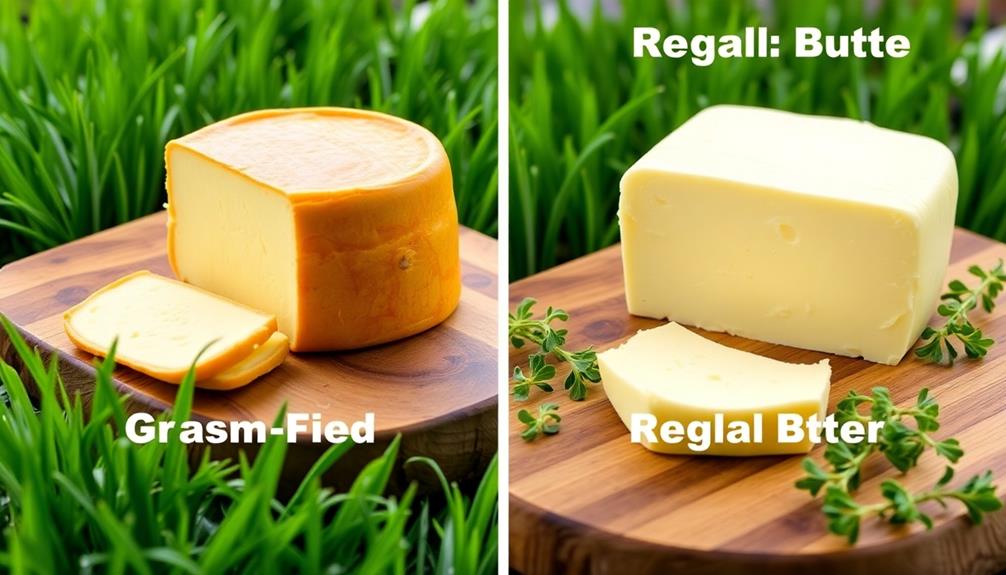Let me guide you through a few easy steps to tackle those annoying butter stains. Believe me, I’ve had my fair share of issues with butter. No matter if it’s clothes, furniture, or carpets, I have the knowledge to assist you.
In this article, I’ll give you the lowdown on different types of butter stains and the best methods for removing them.
So, let’s get started and say goodbye to those stubborn butter stains for good!
Key Takeaways
- There are different types of butter stains, including fresh liquid stains and hardened stains that have solidified on fabric.
- Natural stain removers such as dish soap, vinegar, and lemon juice can be effective in removing butter stains.
- Pre-treating butter stains with natural remedies like dish soap, vinegar, and baking soda can help to remove the stains.
- Vinegar, lemon juice, and baking soda can be used as alternative methods for removing butter stains.
Types of Butter Stains
Now, let’s talk about the different types of butter stains you might encounter.
When it comes to preventing grease stains, it’s important to understand the various types of butter stains that can occur.
One common type is the fresh butter stain, which is when the butter is still in its liquid form.
Another type is the hardened butter stain, which happens when the butter solidifies on the fabric.
Both types can be a nuisance, but there are natural stain removers that can effectively tackle these stains. From dish soap to vinegar or lemon juice, these remedies can help break down the butter and lift it from the fabric.
Now that we know the different types of butter stains, let’s move on to the next step of pre-treating them for successful stain removal.
Pre-Treating Butter Stains
First, you’ll want to apply a pre-treatment solution to help remove those pesky butter stains. There are several natural remedies for butter stains that can be effective in breaking down the grease and removing the stain. Here are some butter stain removal hacks that you can try:
| Method | Ingredients | Steps |
|---|---|---|
| Dish soap method | Dish soap, warm water | 1. Mix dish soap with warm water. 2. Apply the solution to the stain. 3. Gently rub the stain with a cloth or sponge. |
| Vinegar method | White vinegar, warm water | 1. Mix equal parts white vinegar and warm water. 2. Dab the solution onto the stain. 3. Blot the stain with a clean cloth. |
| Baking soda method | Baking soda, water | 1. Make a paste with baking soda and water. 2. Apply the paste to the stain. 3. Let it sit for 15 minutes, then rinse with water. |
These natural remedies can be effective in pre-treating butter stains before washing the garment. Remember to always test the solution on a small, inconspicuous area first and follow the care instructions on the garment.
Using Dish Soap to Remove Butter Stains
To remove butter stains, you’ll want to start by mixing dish soap with warm water. This simple solution is highly effective in breaking down the grease and oil from the butter.
Begin by combining a few drops of dish soap with warm water in a small bowl. Gently stir the mixture until it becomes soapy.
Then, using a clean cloth or sponge, dab the soapy solution onto the butter stain. Gently blot the stain, working from the outside towards the center to prevent it from spreading.
Continue this process until the stain is no longer visible. For stubborn butter stains, you can repeat the process or try using natural alternatives to dish soap such as white vinegar or lemon juice, which also work well in breaking down the grease.
These butter stain removal hacks are great options for those looking for eco-friendly alternatives.
Removing Butter Stains With Vinegar
Using vinegar is a natural alternative that can effectively break down grease and oil from butter stains. It is not only useful for removing butter stains, but also for tackling other types of stains. Vinegar is known for its acidic properties, which help to break down and dissolve grease and oil. To use vinegar as a butter stain remover, simply mix equal parts white vinegar and water, and apply the solution directly onto the stain. Let it sit for a few minutes before laundering as usual.
Here is a table that highlights alternative methods for removing butter stains:
| Method | Ingredients | Steps |
|---|---|---|
| Vinegar | White vinegar, water | 1. Mix equal parts vinegar and water. 2. Apply directly onto stain. 3. Launder as usual. |
| Lemon Juice | Lemon juice, water | 1. Mix equal parts lemon juice and water. 2. Apply directly onto stain. 3. Launder as usual. |
| Baking Soda | Baking soda, water | 1. Create a paste with baking soda and water. 2. Apply onto stain. 3. Let it sit for a few minutes. 4. Launder as usual. |
Now, let’s explore another effective method for removing butter stains: lemon juice.
Lemon Juice as a Butter Stain Remover
Lemon juice, a common household ingredient, can effectively break down and remove stubborn grease and oil stains caused by butter. Its natural acidity helps to dissolve the fats in the stain, making it easier to remove.
However, if you don’t have lemon juice on hand or prefer to use alternatives, there are other natural stain removers that can be just as effective. One option is white vinegar, which works similarly to lemon juice due to its acidic properties.
Another alternative is baking soda, which can absorb the grease and oil from the stain. Simply sprinkle it on the affected area, let it sit for a few minutes, and then brush or vacuum it away.
These lemon juice alternatives are great options for tackling butter stains in a natural and effective way.
Baking Soda for Butter Stain Removal
When it comes to removing butter stains, baking soda is a highly effective and versatile option. It not only helps to absorb the grease and oil from the stain but also has natural deodorizing properties.
If you don’t have baking soda on hand, there are also alternative stain removers that can be just as effective in treating butter stains.
Additionally, I will share some application tips and tricks to ensure the best results when using baking soda or other stain removers on butter stains.
Baking Soda Effectiveness
To effectively tackle butter stains, you’ll find that baking soda works wonders in lifting the grease from your clothing.
However, if you don’t have baking soda on hand, there are some alternatives you can try.
One natural stain remover that can be used is white vinegar. Simply mix equal parts white vinegar and water, and then apply it to the stain. Let it sit for a few minutes before rinsing with cold water.
Another option is lemon juice. Squeeze fresh lemon juice onto the stain and let it sit for a few minutes before washing as usual.
Additionally, dish soap can also be effective in removing butter stains. Apply a small amount of dish soap to the stain, rub gently, and then rinse with cold water.
Remember to always check the garment’s care label and test any stain remover on a small, inconspicuous area first.
Alternative Stain Removers
If you’re looking for alternative stain removers, you might want to consider using white vinegar or dish soap. These natural stain removers can be effective in removing butter stains from your clothes. Here are some techniques you can try:
-
White vinegar:
-
Mix equal parts of white vinegar and water.
-
Apply the solution directly to the butter stain.
-
Gently rub the stain with a clean cloth or sponge.
-
Rinse the area with cold water and launder as usual.
-
Dish soap:
-
Apply a small amount of dish soap directly to the stain.
-
Gently rub the soap into the butter stain.
-
Let it sit for a few minutes.
-
Rinse the area with cold water and launder as usual.
These simple and affordable methods can help you remove butter stains naturally, without the need for harsh chemicals.
Application Tips and Tricks?
Here’s a helpful tip for applying the white vinegar solution: make sure to mix equal parts of white vinegar and water. This solution is an effective stain remover for butter stains.
When it comes to application techniques, it is important to act quickly. Blot the stained area with a clean cloth to remove any excess butter. Then, using a sponge or cloth, gently dab the white vinegar solution onto the stain, being careful not to rub it in.
Allow the solution to sit for a few minutes, and then rinse the area with cold water. One common mistake is using too much vinegar, which can cause discoloration. Remember, always test the solution on a small, inconspicuous area first before applying it to the entire stain.
How to Use Hydrogen Peroxide on Butter Stains
I’ve found that hydrogen peroxide is an incredibly effective stain remover, especially when it comes to butter stains. Its powerful bleaching properties make it perfect for tackling stubborn greasy stains.
To make the most of hydrogen peroxide’s stain-removing power, it’s important to apply it properly and follow a few key tips.
Peroxide’s Stain-Removing Power
You can use peroxide to remove butter stains from your clothes. Peroxide is a powerful stain remover that can effectively break down the oils and fats in butter stains. However, if you prefer not to use peroxide or if you have concerns about its safety, there are alternative methods you can try. Here are some peroxide alternatives to consider:
- Lemon juice: The natural acidity in lemon juice can help break down butter stains and lift them from your clothes.
- Dish soap: Applying a small amount of dish soap directly to the stain and gently rubbing it in can also help remove butter stains.
When using peroxide or any stain remover, it’s important to take safety precautions:
- Test on a small, inconspicuous area first to make sure it doesn’t cause any discoloration.
- Wear gloves to protect your skin.
- Follow the instructions on the bottle and avoid mixing peroxide with other cleaning agents.
Application Tips for Peroxide?
To apply peroxide effectively, remember to dilute it with water before using it on your clothes. This will prevent any potential damage or discoloration to your garments.
Peroxide is a versatile stain remover that can be used for various purposes. It is commonly used to remove tough stains like blood, wine, and grass.
However, if you don’t have peroxide on hand, there are alternatives you can try. Lemon juice, vinegar, and baking soda are all effective stain removers that can be used as substitutes for peroxide.
Lemon juice works well on rust stains, while vinegar is great for removing odors. Baking soda is a powerful stain lifter and can be used on a variety of stains.
Removing Butter Stains From Clothing
First, check the fabric care label for any specific instructions on how to remove butter stains from your clothing. If there are no specific instructions, follow these effective upholstery cleaning methods to tackle the butter stain:
- Blot the stain with a clean cloth or paper towel to remove any excess butter.
- Apply a small amount of dishwashing liquid directly to the stain and gently rub it in.
- Let the dishwashing liquid sit on the stain for about 10 minutes to break down the grease.
- Rinse the area with cold water to remove the soap and butter residue.
If the stain persists, try using alternative stain removers such as white vinegar or hydrogen peroxide.
- Blot the stain again with a clean cloth to absorb any remaining moisture.
- Finally, wash the garment as usual, following the care label instructions.
Butter Stain Removal From Upholstery
When it comes to removing butter stains from upholstery, there are effective cleaning methods that can be used.
In this discussion, I will share quick and easy solutions to tackle those stubborn butter stains.
Additionally, I will provide tips on how to prevent future butter stains on your upholstery, ensuring its cleanliness and longevity.
Effective Upholstery Cleaning Methods
There’s no denying that upholstery cleaning can be a challenging task, but there are effective methods to tackle it.
As an expert in the field, I have found that using the right upholstery cleaning products is crucial for achieving excellent results.
Here are two sub-lists that will help make your upholstery cleaning experience easier:
-
Preparing for the cleaning process:
- Vacuum the upholstery thoroughly to remove loose dirt and debris.
- Test the cleaning product on a small, inconspicuous area to ensure it doesn’t damage or discolor the fabric.
-
Professional upholstery cleaning:
- Consider hiring a professional upholstery cleaning service for deep and thorough cleaning.
- Professionals have the expertise and equipment to handle different types of fabrics and stains effectively.
Quick and Easy Solutions
To make upholstery cleaning quick and easy, I always recommend using a fabric freshener spray. Not only does it eliminate odors, but it also helps to refresh your furniture.
However, when it comes to removing stains, there are alternative stain removers that can be just as effective. One option is a mixture of dish soap and warm water. Simply mix a few drops of dish soap with warm water and dab the solution onto the stained area using a clean cloth. Gently blot the stain until it lifts.
Another effective method is using a mixture of vinegar and water. Mix equal parts of vinegar and water, then spray it onto the stained area. Let it sit for a few minutes before blotting the stain away.
Preventing Future Butter Stains
Now that you know some quick and easy solutions for getting out butter stains, let’s talk about preventing future butter stains. As an expert in upholstery cleaning, I have some helpful tips to keep your carpets and furniture butter stain-free.
Here are some upholstery cleaning tips to prevent butter stains:
- Regularly vacuum your carpets and upholstery to remove any crumbs or debris that could attract butter stains.
- Apply a stain repellent spray to your carpets and upholstery to create a protective barrier against butter and other stains.
To prevent butter stains on your carpets specifically, follow these carpet stain prevention tips:
- Avoid eating buttery snacks on your carpets. Instead, enjoy them at a table or use a tray.
- If you accidentally drop butter on your carpet, act quickly by blotting the area with a clean cloth and using a mild detergent to remove any residue.
Getting Rid of Butter Stains on Carpets
If you spill butter on your carpet, try using a mixture of dish soap and warm water to remove the stain. This is one of the most effective butter stain removal hacks that you can easily do at home.
Start by blotting the excess butter with a clean cloth or paper towel. Then, mix a tablespoon of dish soap with two cups of warm water. Gently apply the solution onto the stain using a sponge or soft cloth, working from the outside towards the center. Blot the area with a clean cloth to absorb the moisture.
Repeat these steps until the stain is gone. If the stain persists, it may be best to seek professional carpet cleaning methods to ensure a thorough and proper cleaning.
Tips for Preventing Butter Stains
You can easily prevent butter stains on your carpets by being careful when handling and consuming butter. Here are some expert tips to help you avoid those pesky stains in the kitchen:
- When using butter in recipes or spreading it on bread, be mindful of how much you’re using to avoid any excess that could spill or drip.
- Use butter dishes or containers with lids to keep the butter contained and prevent it from accidentally spilling onto countertops or other surfaces.
- If you’re melting butter in the microwave, cover the container with a microwave-safe lid or paper towel to prevent any splatters.
- When cooking with butter, use a splatter guard or lid on your pans to keep any hot butter from splashing onto countertops or stovetops.
- If a butter stain does occur on your countertops, quickly blot it with a clean cloth or paper towel to remove as much of the butter as possible before it sets in.
Frequently Asked Questions
Can I Use the Same Method for Removing Butter Stains From Clothing and Upholstery?
Yes, you can use the same method for removing butter stains from clothing and upholstery. Using vinegar to remove butter stains is effective, and there are also alternatives to dish soap that work well.
Will Using Dish Soap Remove Butter Stains From Delicate Fabrics?
Using dish soap can effectively remove butter stains from delicate fabrics. However, if you’re looking for alternatives, you can try using cornstarch or talcum powder to absorb the grease before washing.
Can I Use Lemon Juice to Remove Butter Stains From Colored Clothing?
Lemon juice can be an effective alternative to remove butter stains from colored clothing. Other alternative stain removal methods can also be used, but always test on a small, inconspicuous area first.
How Long Should I Let Baking Soda Sit on a Butter Stain Before Washing It?
Before washing a butter stain, I let baking soda sit on it for about 30 minutes. It helps absorb the grease. Another effective method is using vinegar to remove the stain or cornstarch to absorb it.
What Is the Best Way to Prevent Butter Stains on Carpets?
To prevent butter stains on carpets, it’s important to be mindful when handling butter. Keep it away from carpets and use caution when eating near them. If a stain occurs, promptly remove it to prevent permanent damage.
Conclusion
In conclusion, removing butter stains can be quite a hassle, but with the right techniques, it can be done effectively.
By pre-treating the stain, using dish soap or vinegar, or even lemon juice, you can tackle those stubborn butter marks.
Whether it’s on clothing, upholstery, or carpets, there are specific methods for each.
Remember, prevention is key, so be cautious when dealing with butter to avoid future stains.
Don’t let butter stains ‘spread like wildfire’ – take control and keep your fabrics butter-free!









